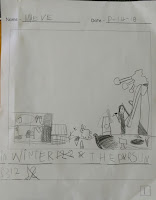Children write throughout the day; in response to a morning message prompt, adding labels to their block structures, or including a sticky note next to their saved math work. The process of thinking, planning,
writing and reflecting is ongoing and occuring in and outside of our designated workshop time. This is important to share, because in no way should the skills, strategies, and growth of the children be contained to one part in our day. When looking at their growth as writers over time, I always consider two questions;
Are they taking initiative of their learning and solving problems independently? Are they transferring their developing skills and knowledge, enriching their learning by applying skills in different content areas?
A couple of weeks ago we began our writing workshop by celebrating that all of the children are writers - and they are. Every five and six year old I have ever known has loved to talk about what they are an expert in and tell stories. Children have been learning the logistics of the writing workshop while also learning about a specific kind of writing; informational. We have started the year writing teaching books, connecting the children's work to the teaching books they have been reading during reading workshop and the important community piece of getting to know more about our new community through their writing. Following Ana's recent share of her teaching book about caterpillars, one peer exclaimed,
"I didn't know Ana knows about caterpillars! What does bad caterpillar mean? AND LOOK AT HER DRAWINGS!"
The children are not only individual writers, they are part of a writing community - sharing and reflecting with their peers. As you look at the small collection of photographs on this post, think about some of these questions;
What am I learning about the child through their writing? What are they interested in and passionate about? What are their strengths? What is one thing they are working on?
One thing we have been working on during writing workshop is
s t r e t c h i n g words and listening for all of the sounds. You will see children using a letter to show the starting sound in a word for their labels. You will also see children beginning to write on the lines below their drawings. We encourage this detail in their work, but only after they have thought about their piece and put their thoughts into drawings on their paper. The goal is not to spell words correctly, the goal is for students to listen and record the sounds (letters) they hear. We practice this skill when working on our class teaching book about the big playground and they practice in their individual teaching books. We are in the beginning of this process and I am sure this week children will be adding many pages to their books!

Practicing picturing the big playground in our minds and drawing and labeling what we see.
What else can we add to our book? What are the important details about the playground we need to teach to our audience?
Ana is working on a teaching book about caterpillars. There are leaves and one chrysalis on the tree. There are different caterpillars on the ground and on the branch. She said the caterpillars on the ground are poisonous.
"How can you share that important detail?"
"I could try to write poisonous, but I'll write bad. Because it means they are bad. Don't touch them."
Crosby is writing a teaching book about dragons. Every page has a fact about a different kind of dragon. Did you know rainbow dragons can spread rainbows?
Amelia is writing a teaching book about dinosaurs.
Maeve is writing a teaching book about pet bunnies.
"In Winter the person is 12."
Her plan is to write about how a 12 year old person can take care of a 2 year old bunny. This is a very specific teaching book.
Dylan is teaching us about snakes.
Reagan is teaching us about her family. She is using the zones of regulation to label how her and her parents are feeling. When talking about her work, I must note her laughter and smile when saying dad is "in the yellow zone".


























































